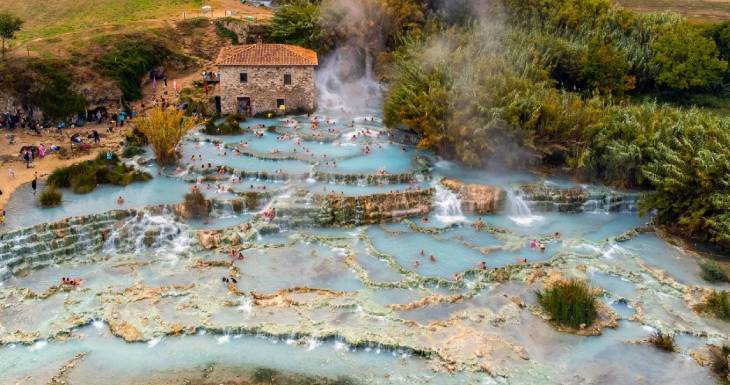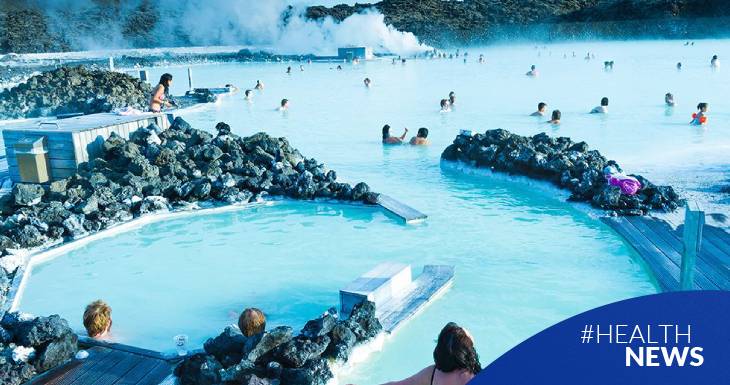Since ancient times, hot springs have been considered a natural source of health and well-being. Their origin is found in the depths of the Earth, where the water is heated by volcanic or geothermal activity and emerges to the surface enriched with essential minerals.
Civilizations such as the Roman, Egyptian and Japanese have taken advantage of these springs for relaxation and healing, establishing spas that today remain favorite destinations for those seeking rest and relief from various ailments.
In ancient Rome, for example, hot springs were places of social and political meeting, where important matters were discussed while enjoying a relaxing bath. In Japan, hot springs, known as "onsen," have been an integral part of Japanese culture for centuries. The Japanese believe in the healing powers of these waters and visit them regularly to relax and rejuvenate the body and spirit.
Today, hot springs remain popular around the world, attracting tourists in search of rest, relaxation and well-being.
Why are hot springs beneficial?
Hot springs contain a rich combination of minerals such as iron, calcium and magnesium, which provide multiple benefits:
- They stimulate blood circulation, promoting the transport of oxygen and nutrients to the tissues.
- They strengthen the immune system, helping to prevent diseases.
- They are an ally in the treatment of chronic diseases, such as arthritis, rheumatism and certain skin conditions.
- They increase body oxygenation, promoting a feeling of vitality.
- They improve tissue nutrition, helping cell regeneration.
Cold or hot? The perfect combination
One of the most commonly used methods in thermal centers is alternating between hot and cold water. This thermal contrast offers additional benefits:
- Hot water relaxes muscles, relieves pain and dilates blood vessels, improving circulation.
- Cold water tones the body, closes the skin pores and helps reduce inflammation.
Alternating temperatures strengthens the body's resistance, activates the metabolism and provides an immediate feeling of revitalization.
Who should avoid hot springs?
Despite their many benefits, not everyone can enjoy hot springs without caution. It is recommended to avoid their use in the following cases:
- People with serious cardiovascular problems, since the heat can affect blood pressure.
- Pregnant women, especially in the first months of pregnancy, due to the possible effects on blood circulation.
- People with skin infections or open wounds, to avoid complications or contagion.
- Patients with neurological diseases, which may affect their ability to regulate body temperature.
From volcanic lands to glacial landscapes, these natural oases offer a refuge of tranquility and healing
Hot springs are much more than simple outcrops of hot water; they represent a natural treasure full of history, culture, health benefits and economic development opportunities for local communities. Their importance goes beyond the physical and material, reaching the spiritual, social and environmental. Whether to improve health or simply enjoy a moment of tranquility, immersing yourself in a hot spring is a ritual that has transcended generations and borders.
Although there are no world statistics detailing the exact percentages of minerals in each hot spring, it is possible to classify hot springs according to the predominant minerals in their composition:
- Ferruginous waters: rich in iron, they are especially effective in treating deficiencies of this mineral and certain liver conditions.
- Chlorinated waters: they contain chlorine and stimulate digestive secretions, among other benefits.
- Sulphurous waters: with a high sulphur content, they are widely used in medical hydrology for various therapies.
- Sulfated waters: in addition to sulphur, they may contain sodium, calcium, magnesium or chlorine, and are used in multiple therapeutic applications.
- Bicarbonate waters: rich in bicarbonate, they are usually cold and alkaline, and are used to treat states of gastric acidity.
The specific proportion of these minerals in each hot spring depends on local geological factors, such as the type of rocks and sediments present in the area.
Among the five most renowned hot springs for their mineral properties and health benefits in the world we can mention:
- Blue Lagoon (Iceland) Located in a lava field in Grindavík, this geothermal lagoon is famous for its high concentration of silica and minerals, ideal for skin care. Its temperature is around 38°C and is especially beneficial for people with dermatological problems such as psoriasis.
- Pamukkale (Turkey) Known as "Cotton Castle", these hot spring terraces rich in calcium and bicarbonate form natural pools of bright white color. Its waters are believed to help relieve muscle problems, arthritis and digestive disorders.
- Saturnia Hot Springs (Italy) These sulphurous waters in Tuscany emerge at 37.5°C and are renowned for their detoxifying and relaxing properties. They are ideal for improving blood circulation and relieving respiratory and rheumatic conditions.
- Banff Upper Hot Springs (Canada) Located in Banff National Park, these hot springs are loaded with minerals such as sulfate, calcium and bicarbonate. They are recommended for relieving muscle pain, reducing stress and improving breathing at high altitudes.
- Glenwood Hot Springs (United States) In Colorado, you will find the largest thermal pool in the world, rich in minerals such as sodium, calcium and magnesium. Its waters help relax muscles, improve circulation and strengthen the immune system.

Termas de Saturnia - Italy
If you are looking for a unique experience to revitalize body and mind, these therapeutic waters and their natural environment are a perfect refuge for peace and relaxation. .


